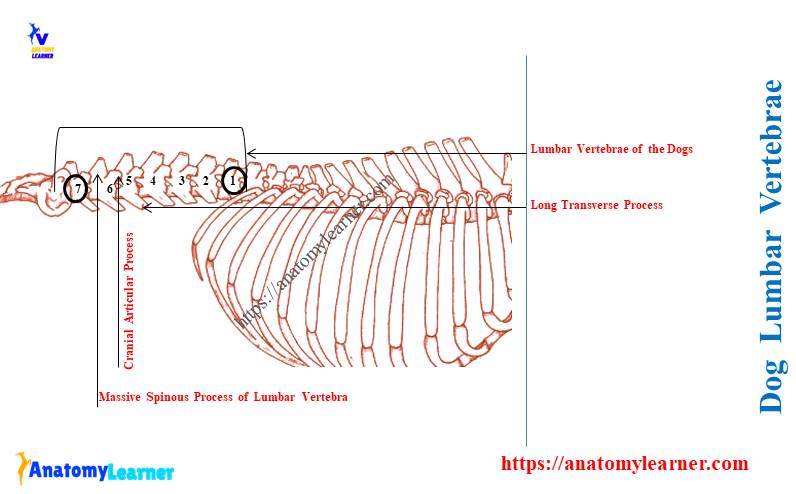The dog lumbar vertebrae form the lumbar part of the spine. You will find a little variation in the dog’s lumbar vertebra bone structure compared to other animals.
I will show you the canine lumbar vertebrae anatomy with the labeled diagram. Thus, you may easily understand the basic structure of these vertebrae with their actual number.
Quick overview: you will see 7 lumbar vertebrae in the dog spine that form the loin or lower back region. The unique features of the canine lumbar vertebrae are a broader body and a long plate-like transverse process.
Again, I will also show you the primary difference in the structure of the ruminant and canine lumbar vertebrae. So, to learn the structure of the canine lumbar vertebral bones, let’s continue this article.
Dog lumbar vertebrae
In the dog lumbar vertebrae, you will find the typical features of the body, arches, and processes. So, let’s identify the osteological features from the body, arches, and processes of the canine lumbar vertebra.
Before that, you may also know the typical structure of the animal vertebra from the below-mentioned article –
Okay, let’s try to identify the below-mentioned osteological features from the canine lumbar vertebra –
- Body, arches, and processes of the canine lumbar vertebra,
- Cranial convex and caudal concave surfaces from the lumbar vertebral body,
- Right and left pedicles and laminae (arches of the canine lumbar vertebrae),
- Cranial and caudal vertebral notches on the pedicles (on both aspects),
- Vertebral foramen on the canine lumbar vertebra bone,
- Cranial articular process of the dog lumbar vertebra,
- Caudal articular process of the dog lumbar vertebra,
- Mammillary process in the structure of the cranial articular process of the canine lumbar bone,
- Longer plate-like transverse processes (on both sides of the body),
- Larger and massive spinous process (single) of the dog’s lumbar bone, and
- An accessory process on the first three or four lumbar vertebrae of the dogs,
All these above-mentioned osteological features are identified in the canine lumbar vertebrae labeled diagram. You will find more labeled diagrams on the dog lumbar vertebra in the next section of this article.
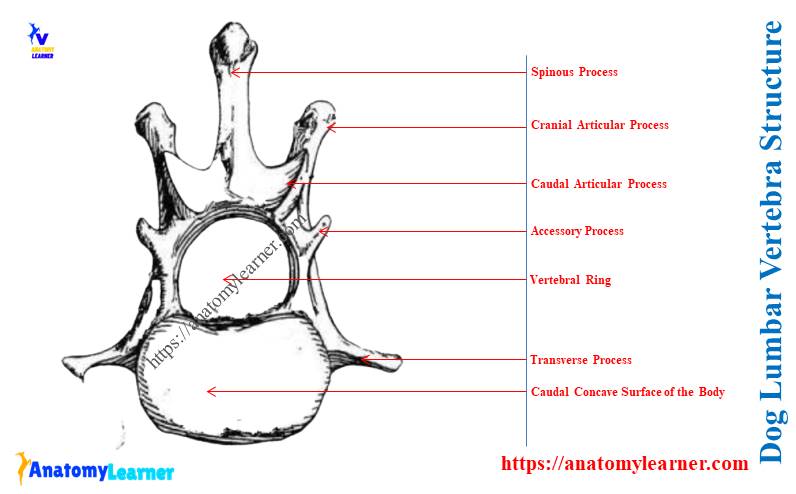
Where are the lumbar vertebrae in a dog?
These lumbar vertebrae are located on the spine in between the thoracic and sacral vertebrae. They together form the basic lumbar part of the canine spine anatomy.
If you want to know the details anatomical features of the dog spine, you may read the below-mentioned article from anatomy learner –
You may easily differentiate the dog’s lumbar bone from the thoracic and sacral bones. In the dog thoracic vertebrae, you will find the longer spinous process and costal facets in their bodies.
Again, you may learn the details of the canine thoracic vertebrae that I have already discussed in the following article –
You will get the typical features of the dog thoracic vertebrae with their total number from the above-mentioned article. Again, the last lumbar vertebra of the dog spine articulates with the first sacral vertebra.
You will find total 3 sacral bones in the structure of the canine sacrum. In contrast, the ruminant sacrum bone possesses 5 fused sacral vertebrae.
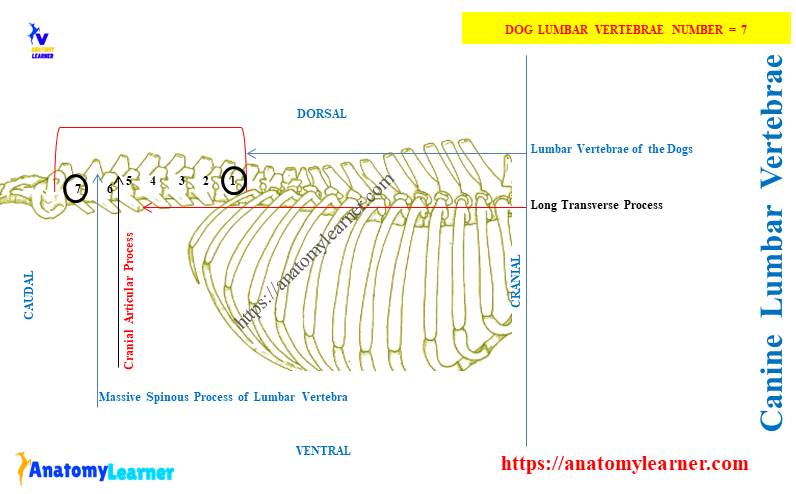
How many lumbar vertebrae does a dog have?
Quick answer: the dog has 7 lumbar vertebrae in its spine. All these lumbar vertebrae are characterized by the long and broader body and longer plate-like transverse processes.
These 7 (seven) lumbar vertebrae also show the more extensive, more massive, dorsally directed spinous process. The first 3 or 4 canine lumbar vertebrae possess accessory processes absent in the last lumbar bones.
The number of lumbar vertebrae in different animals varies. You may find the following numbers of lumbar vertebrae in the various animals (in Table 1) –
| Animals | Number of lumbar vertebrae |
| Dog | 7 |
| Horse | 6 Sometime 5 in few horse breed |
| Ox or cow | 6 |
| Sheep | 6 – 7 |
| Pig | 6 – 7 |
| Rabbit | 6 – 7 |
Unique features of dog lumbar bone
Now, it will be very easy for you to enlist some of the important osteological features of lumbar bone. I will show you the most important features of the canine lumbar bone below –
- The body of the canine lumbar vertebra is literally compressed dorsoventrally (they become gradually flattened),
- The body of the lumbar bone shows a less convex cranial surface and less concave caudal surface,
- The neural ring made by the pedicle and lamina is rounded in the first 3 or 4 lumbar vertebrae,
- You will find the cranially directed longer plate-like transverse process in the structure of the canine lumbar vertebra (unique feature),
- The cranial and caudal articular processes (aP) of the canine lumbar bone are well-developed,
- Sometimes the cranial articular process of dog lumbar bone shows the accessory process,
- You will find the quadrilateral plate-like spinous process, which shows uniform height, and
- The intervertebral foramen is larger in the dog’s lumbar bone,
Thus, with the help of these above-mentioned unique features, you may quickly identify the dog’s lumbar bone.
Dog lumbar vertebrae anatomy
In this section of the article, I will discuss the anatomy of the dog’s lumbar vertebra. Here, you might describe the followings from a dog’s lumbar vertebra –
- Structure and features of the body of a dog’s lumbar bone,
- Features of the pedicles and laminae of the dog lumbar bone, and
- Osteological features of the various processes of the dog lumbar bone,
You know, the pedicle and lamina form the arch of the animal vertebra. Here, you will find two pedicles and two dorsal laminae in the structure of the dog lumbar bone.
Again, all the lumbar vertebrae possess the three processes –
- Paired articular process of the canine lumbar bone (cranial and caudal articular process),
- The single spinous process of the dog’s lumbar bone, and
- Paired transverse process of the canine lumbar bone,
First, start with the anatomy of the body of a dog’s lumbar vertebra.
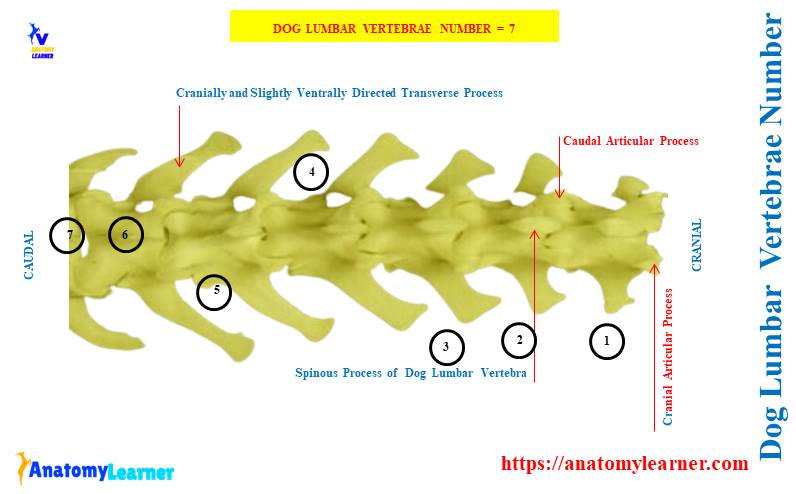
Body of the canine lumbar vertebra
The bodies of the canine lumbar vertebrae are longer and wider than these of the thoracic vertebrae. They are dorsoventrally flattened; thus, the body becomes wider than other vertebral bones.
The width and length of the body increase gradually from the first to the last lumbar vertebrae. But, the length of the seventh lumbar vertebra is the same as the first lumbar.
You will typically find the two extremities in the structure of the dog lumbar vertebra. Here, the extremities of the body are –
- Cranial less convex extremity or surface, and
- Caudal less concave extremity or surface,
You will also find the 2 main surfaces in the structure of the body of a canine lumbar bone –
- Dorsal surface – flat and contains two foramina, and
- Ventral surface – constricted and possess two or more indistinct foramina (sometime they may be absent in the ventral surface),
Again, the dorsal surface of the body forms the base of the neural foramen or ring. You will not find any other special osteological features in the structure of the body of a canine lumbar bone.
Pedicle and lamina of dog lumbar bone
The pedicle is the lateral mass of the canine lumbar bone. In contrast, the pedicle is the dorsal thin masses of the plate-like structure of the lumbar vertebra.
You will find massive and longer pedicles and laminae in the dog’s lumbar bone. The osteological features of the pedicles and laminae of the lumbar bone are almost similar to the typical vertebra.
But the notches on the pedicle (on both cranial and caudal aspects) are somewhat different than these of the thoracic vertebrae. You will find small cranial notches on the cranial aspect of the pedicle.
But, the notches on the caudal aspect of the lumbar’s pedicle are larger, forming the larger intervertebral foramina.
Processes of the dog’s lumbar bone
You will find two pairs of articular processes in the structure of the dog lumbar vertebrae. Here, these articular processes of the lumbar vertebrae are located on the sagittal plane.
The cranial pair of articular processes possess the articular surfaces on its dorsomedial aspect. Again, the caudal pair of the articular processes possess the articular surfaces on its ventrolateral aspect.
The caudal articular process lies in the cranial articular process of the adjacent vertebra and forms the restricted flexion joint. You may get an overview of the various joints from the animal body from the below-mentioned article of anatomy learners –
The cranial articular processes of all the lumbar vertebrae show an extra bony extension. This is the mammillary process of the cranial articular process.
The transverse process of the canine lumbar vertebra shows the unique osteological feature. You may easily identify the canine lumbar bone with the features of a transverse process.
Here, the transverse processes of the dog lumbar bone are longer and plate-like bony extensions. They arise from the junction between the body and the pedicle of the lumbar vertebra.
The direction of the transverse processes of the dog lumbar bone is also unique. You will find the cranially and slightly ventrally directed transverse process in the dog’sdog’s lumbar bone.
Again, the length of the transverse process (laterally) is uniform. But, sometimes, few dogs show the longest transverse process in the mid-lumbar region.
The spinous process of the dog’s lumbar bone
The spinous process of the dog’s lumbar bones is also massive and longer. But, they become more massive and show the highest length in the mid-lumbar region.
Some dogs also show uniform height in the lumbar’slumbar’s spinous process. You will also see the slight cranial inclination in the structure of the canine lumbar spinous process.
This is another identifying feature of the spinous process of a dog’s lumbar. Typically, the ruminant’sruminant’s lumbar vertebra shows the dorsal-directed spinous process.
You may learn more about the osteological features of the ruminant lumbar vertebra from the below-mentioned article –
Accessory process of the canine lumbar vertebrae anatomy
These are the extra bony extension in the structure of canine lumbar vertebrae. Not all the lumbar vertebrae of the vertebral column possess this accessory process.
The first three or four lumbar vertebrae of the canine spine possess the accessory process. But, you will not find this extra process in the structure of the fifth, sixth, and seventh lumbar vertebrae.
The accessory process in the first 3 or 4 lumbar vertebrae is well-developed. You may quickly identify them as they overlie on the caudal vertebral notches.
Again, they extend caudally lateral to the articular process of the succeeding lumbar vertebrae. Here, the diagram shows the accessory process of the canine lumbar vertebrae anatomy.
Canine lumbar vertebrae anatomy labeled diagram
Now, I will show you again the various osteological features of the canine lumbar vertebrae with a diagram. Here, I tried to show you the unique and typical features of the body, arches, and processes of the dog’s lumbar bones.
The dog lumbar bone labeled diagram identifies the longer and wider body. Again, the cranial and caudal ends of the body are identified in the diagram.
The neural ring that is formed by the body, pedicles, and laminae is also identified in the diagram. Here, I tried to show you the small cranial and larger caudal notches from the pedicle of the lumbar vertebra.
The labeled diagram also shows the strong and massive laminae. You will see the cranial and caudal articular processes from the dog lumbar bone labeled diagram.
The unique transverse processes (longer and cranially directed) are also identified in the diagram. You will find the massive and slightly cranially directed spinous process in the lumbar vertebra labeled diagram.
You may also find more labeled diagrams on the canine lumbar vertebra here.
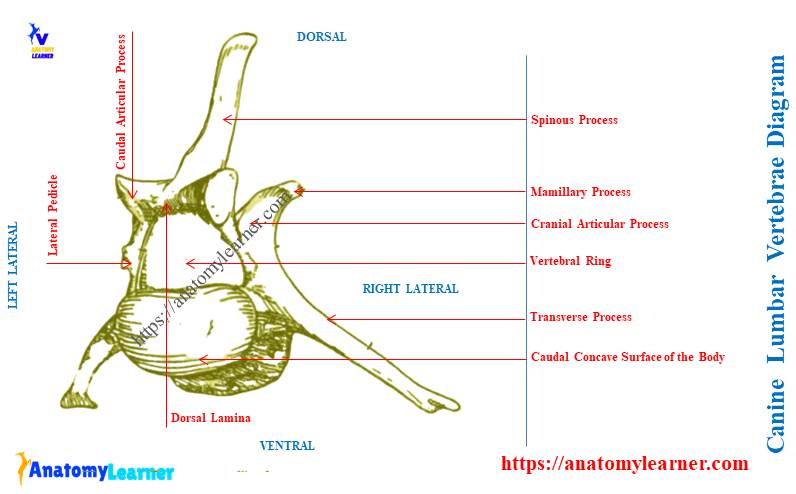
How to differentiate a dog’s lumbar vertebra from a ruminant?
Answer: the dorsoventrally flattened body and cranioventrally directed larger transverse process are unique features in dog lumbar vertebra. With the help of these two important osteological features, you may easily differentiate the dog’s lumbar bone from the ruminant.
Here, the body of the dog’s lumbar bone is flattened. In contrast, the body of the ruminant lumbar vertebra is constricted in the middle. You will also find the larger expansion at either end of the ruminant (ox, sheep) lumbar vertebra.
You will also find the rudimentary ventral crest in the ventral aspect of the ruminant (ox) lumbar bone. But, the ventral crest is almost absent in the ventral surface of the canine lumbar bone.
The transverse process of the dog lumbar is a thin plate-like structure. It is directed cranially and slightly ventrally, which is unique in dogs.
But, the transverse process of the ruminant or ox lumbar vertebrae is curved laterally. They also possess the expanded ends on the structure of the transverse process.
You will also find the difference in the structure of a cranial articular process. The articular process of the dog lumbar bone is larger and compressed laterally.
Again, the cranial articular process is comparatively smaller than the caudal. And it also possesses strongly curved facets.
There is also a difference in the formation and direction of the spinous process of the dog’s and ruminant lumbar bone. The direction of the spinous process is cranial in dogs, whereas it is dorsal in ruminants.
Let’s see the significant difference between the dog and ruminant (ox) lumbar bone from Table 2 –
| Features | Dog Lumbar | Ox Lumbar |
| Number | 7 | 6 or 7 |
| Body | Constricted at middle Possess ventral crest | Flattened dorsoventrally |
| Transverse process | Cranioventrally | Curve laterally |
| Spinous process | Cranially directed | Dorsally directed |
Dog vs. horse lumbar vertebra
You will also find distinct features in the horse lumbar vertebra compared to the dogs. First, you will find the variation in the number of lumbar vertebrae in horses.
The spine of a horse (or vertebral column) shows six lumbar vertebrae. Sometimes you may find 5 (five) lumbar vertebrae in some Arabic horses.
The body of the horse’s lumbar vertebrae shows a semi-elliptical appearance. You will find the distinct ventral crest in the horse’s lumbar vertebral bone structure.
The cranial articular process of the horse lumbar bone possesses dorsally directed concave surfaces. Again, the transverse process of the equine lumbar vertebra is an elongated plate-like structure.
This transverse process of the horse lumbar bone is also flattened dorsoventrally.
These are the most unique osteological features in the horse lumbar vertebrae. And these help you to differentiate the horse lumbar from the canine lumbar vertebra.
Does the dog possess 8 lumbar vertebrae?
Answer: in some cases, you may find 8 lumbar vertebrae in the dog. But this is very rare and restricted in some larger breeds of dogs.
But, typically, you will find 7 (seven) lumbar bones in the structure of the canine vertebral column.
Sometimes the last lumbar vertebra may fuse with the first sacral vertebra in the abnormal dog. In this case, the total number of canine lumbar vertebrae is 6.
Why are canine lumbar vertebrae important?
Answer: the dorsal and ventral branches of the lumbar spinal nerve travels through the dorsal and ventral aspect of the transverse process. Again, you may find various issues in the lumbar spine of a dog.
Thus, you might understand the course of lumbar spinal nerve and lumbar issues in dogs. So, it is essential to learn the structure of the canine lumbar bone.
Conclusion
So, the dog lumbar vertebrae possess all the typical features of an ideal animal vertebra. The unique features of bodies and transverse processes help you to identify the canine lumbar vertebrae from others.
The cranial articular and spinous processes of the dog lumbar vertebra also show unique features. You may also differentiate this bone with the help of the direction of the spinous process from other’s lumbar vertebrae.

